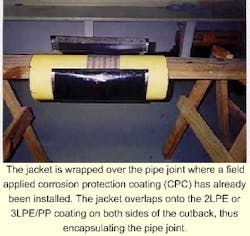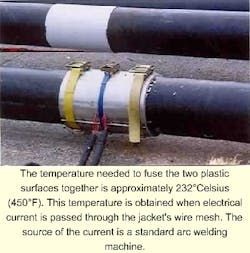New Field System Provides Pipe Joint Protection
By Clifford Bennett
Two layer Polyethylene (2LPE) extruded coatings have been used on pipelines for quite some time. It's successor, three layer PE (3LPE) and Polypropylene (3LPP), are recognized to be the most rugged plant applied corrosion protection available for underground and sub-sea pipe. While use of both these coatings is increasing, they are still in limited use on pipelines in the USA.
Many overseas installations, both US and foreign owned, use 2LPE & 3LPE/PP plant applied coatings. Some owners seem to have jumped straight from Coal Tar to 3LPE/PP coatings. 3LPE/PP has become the top choice of international pipeline projects designed for a life expectancy over 25 years.
The 3LPE coating has a long track record of being the best performing pipe body coating in rugged conditions up to 82° Celsius (180° F). It's sister, 3LPP, holds the same status for temperatures up to 110° Celsius (230° F).
Field Joint Issues
Perhaps the obvious application of the 2LPE and 3LPE/PP extruded coatings is in severe conditions. High operating temperatures, aggressive soil conditions, sub-sea pipe and risers, Horizontal Directional Drilling (HDD) or a combination of these conditions are all applicable to this super plastic coating.
A serious issue with the 2LPE and 3LPE/PP coatings has been the corrosion and mechanical protection of the field joint area on the pipeline. Since pipe is welded together in the field, plant applied girth weld coatings are not an option.
Up to the recent past, economical, simple and quick field applied joint coatings that could match the robustness of the 3LPE/PP plant applied coating were non-existent. Many corrosion protection joint coatings will fail long before the pipe body 3LPE/PP coating. Some companies are rumored to have avoided using the 2LPE and 3LPE/PP coatings, since in technical comparison, an adequate pipe joint protection did not exist.
Field Joint Protection
Recently, a new field joint protection coating for 2LPE and 3LPE/PP coated pipe has been developed. The patented system is called the Fusion-WeldField Joint Protection system. The system is simply a plastic jacket or sleeve that thermally bonds to the PE or PP extruded coating on the pipe. The jacket is made of high density PE or PP, chosen to match the coating material.
The jacket is "fused" onto the pipe coating. The process is much like a toaster-heating element being sandwiched between two plastic surfaces then being heated to the plastic's melting point. The plastic then melts into each other, fusing the connection as the plastic cools.
In the case of the Fusion-Weld System, the toaster-heating element is a conductive wire mesh attached to three edges around a rectangular jacket. The jacket is one surface of plastic, the second plastic surface is the extruded PE/PP coating on the pipe. The jacket is wrapped over the pipe joint where a field applied corrosion protection coating (CPC) has already been installed. The jacket overlaps onto the 2LPE or 3LPE/PP coating on both sides of the cutback, thus encapsulating the pipe joint.
The temperature needed to fuse the two plastic surfaces together is approximately 232° Celsius (450° F). This temperature is obtained when electrical current is passed through the jacket's wire mesh. The source of the current is a standard arc welding machine. The current is distributed to the mesh on the Fusion-Weld Jacket by an "Electro-Clamp" which wraps around the jacket on the pipe. The only areas exposed to the fusion temperature are immediately above and below the wire mesh on the edges of the jacket.
The current used to fuse the jacket varies due to changing pipe diameters and coating thickness. So far, the maximum time encountered was on a 36 inch diameter pipe with a 3LPE, 3 mm (118.1 mils) thick coating. This joint took the system 60 seconds to fuse.
The system's control box, attached between the weld machine and Electro-Clamp, times the current being applied and shuts off when the set time has expired. This avoids human error and inaccuracies.
After cooling approximately 25 seconds, the Electro-Clamp is removed, exposing an almost indestructible plastic armored pipe joint coating. The corrosion protection coating under the Jacket is untouched and mechanically protected.
The system is considered mainly as a field joint mechanical protection though it also acts as a secondary CPC. Since fusion is not 100 percent (not completely air or watertight), it is not recommended as a primary CPC. The function of the system is primarily mechanical protection.
Other Technical Considerations
Thickness. Although the jacket of the Fusion-Weld System (FW) can be made in any thickness between .762 to 3.17 mm (30 to 125 mils), the most commonly used jacket thickness is 1.52 mm (60 mils). When the jacket thickness is added to the corrosion protection coating thickness underneath, the total system thickness could range from 1.52 to 6.22 mm (60 to 245 mils). Recommended jacket thickness depends on the severity of the application.
Maximum Thickness. The thickest jacket used thus far is 3.17 mm (125 mils). The only limiting factor is its ability to wrap around the pipe. For instance, a 4 inch diameter pipe would be difficult to wrap with a 3.17 mm jacket. Such a thick jacket lacks the flexibility to conform to the surface of this small a pipe.
More importantly, the CPC thickness must be limited. The CPC thickness should not exceed the thickness of the extruded pipe coating. Greater thickness of the CPC over the extruded plastic pipe coating may cause a bulge effect to occur which may be damaging in HDD and other applications. If the jacket width allows only 2-3 inches overlap onto the PE/PP extruded coating, and the CPC exceeds the thickness of the 2LPE or 3LPE/PP coating, the FW jacket may not bond properly due to improper contact with the PE/PP extruded coating. Also, the mesh edges may become wrinkled thus not allowing the area to fuse.
Air gap between FW Jacket and CPC. If the CPC is thinner than the extruded plastic pipe coating thickness, then an air gap between the FW jacket and the CPC will occur. The air gap cannot contact the pipe metal surface since the CPC is airtight. The air gap cannot cause pressure to build since the fusion is not 100 percent.
Depending on your point of view, this may or may not cause concern. The solution to the air gap is to accurately specify the thickness of the CPC to equal or be slightly greater than the extruded pipe coating thickness.
The Electro-Clamp function is to distribute the electrical current in a uniform manner to the jacket. The clamp is designed to be lightweight and flexible. The clamp must wrap around and tighten over the jacket held on the pipe in order to permit proper contact to be made. The purpose of the ratchet clamps and belts is to apply pressure on the contacts. Each clamp must be sized to the jacket dimensions. Aligning the view hole on the clamp with the black marking on the jacket guarantees correct positioning.
Repairing damaged jackets or pipe coating areas immediately adjacent to a jacket may be necessary from time to time. For example, heavy equipment sometimes wanders in the path of the pipeline. The first thing to do if damage occurs is to make sure the air and watertight CPC bond to the pipe is not broken. The slightest defect, or holiday, can cause a corrosion cell.
Repairing jackets is a simple procedure achieved by fusing a second jacket over the damaged jacket area. One end of the second jacket overlaps over the holiday, with the other extending past the edge of the jacket to the extruded pipe coating. In extreme cases a much wider jacket can be applied over the entire damaged jacket. In theory, FW jackets can overlap indefinitely.
Fusing over pipe PE/PP defects where the mesh would overlap on the defect is not recommended. In order to fuse in that area a repair patch with an outside layer of PE/PP must be used such as a PE/PP melting stick. If the outer layer of the defect is not plastic, fusion will not take place in that area. Again, in extreme cases, a much wider jacket can be applied over the entire damaged jacket.
Corrosion Coatings - Any type of CPC can be used under the FW System as long as it has an acceptable bond to steel and PE or PP.
Cathodic Protection
If Cathodic Protection Shielding is an issue, the FW jacket should be perforated to prevent shielding. Perforated jackets are only slightly weaker mechanically than those that are non-perforated.
Ultraviolet (UV) Exposure
PE and PP are not known for their UV resistance. If a system is to be installed above ground, it is recommended that the joint be wrapped with an economical vinyl tape.
Closing
Responding to changing conditions with new technologies is imperative in our industry. The Fusion-Weld System is another example of this. The ability to design an effective fusion-weld mechanism that is adaptable to field use anywhere in the world solves a major problem for pipeline installers.
About the Author:
Clifford "Kip" Bennett is Vice President of International Sales and Special Projects for the Tapecoat Company, a division of TC Manufacturing. He has been involved in the corrosion control, oil/gas and water markets for a number of years, and an active member of NACE since 1989.

